If you have bulk liquid to ship across the country, you might be feeling nervous about the prospect. There’s a lot of trust involved with bulk liquid transport, after all; you have to trust that your carrier has sanitized their tank to prevent contamination, has checked their entire rig for leaks, and can deliver your product on-time and in good condition. This makes it imperative that you work with a trusted, reliable shipping partner from the beginning. Transporting liquid in bulk can seem like a daunting task if you’ve never done it before, but with the right information and a good shipping partner at your side, it doesn’t have to be difficult.
Bulk liquid transport involves transporting the bulk liquid shipment in a tanker truck, instead of in drums or tanks. That tank can then be shipped like any other kind of truckload freight.
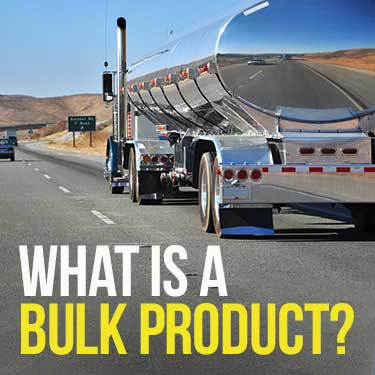
The term “bulk” is used to describe non-containerized, loose goods that are moved in mass quantities or volumes.
Products shipped as bulk loads are packed into one large container to be moved, such as a tank or a shipping container, so it is much more straightforward than packaging goods in smaller containers before shipping. This is useful for moving goods that aren’t intended for general consumers, such as raw materials, ingredients for food manufacturing, and materials for landscaping. Some examples of goods that are commonly shipped in bulk loads are gravel, dried beans, oil, and grains.
Goods that are packaged in “bulk containers,” such as bulk bags, bins, or barrels, are no longer considered “bulk” goods. Once a bulk shipment is broken down into smaller containers, even if those containers are 55-gallon drums or 250-gallon tanks, it is then referred to as a “break bulk” shipment. The distinction is an important one to know because bulk shipments are handled as loose goods, whereas break bulk shipments are loaded individually in containers.
When you have a product to ship, you need to be able to communicate with your shipping partners about what kind of service you need: bulk or break bulk. A miscommunication can end up costing you quite a bit of time and money, after all.
It’s important to keep in mind that, when talking about ocean cargo, “break bulk” shipping can also refer to products that are too large to fit inside a standard shipping container. That can include construction equipment, turbine parts, and large machinery. Don’t let the two meanings for the term confuse you!
Want to know more about the future of bulk transportation and freight shipping? Learn more about green logistics.
Bulk transportation trucking refers to the act of moving bulk quantities of goods by road, with the use of a freight truck.
When bulk goods must be transported across land, freight trucks are the easiest solution. There are many different kinds of specialized truck trailers to transport bulk goods, but all of them are designed to contain and protect the product being shipped.
Whether the product is being moved in a large tank, or a hydraulic dump trailer, the main goal is always to prevent loss of goods. If any amount of the load spilled out of the trailer, that could mean huge losses in revenue. Not only that, but if something like a piece of gravel or a large tree nut flew out of the back of the trailer, it could become a dangerous projectile.
Is your business new to shipping freight? Learn more with our guide to freight shipping.
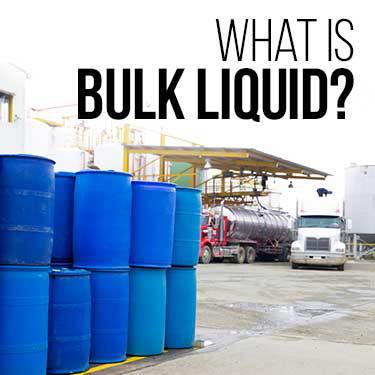
A “bulk liquid” is a large volume of liquid that is transported without being packaged into individual containers.
Like with dry bulk goods, bulk liquids are pumped directly into the back of a specialized freight truck. These types of liquids are often used in manufacturing, food processing, agriculture, and much more! Here are some examples of the types of liquids that are commonly shipped as bulk liquid shipments:
Need help shipping soda in bulk? Check out our article on Shipping Soda by the Truckload.
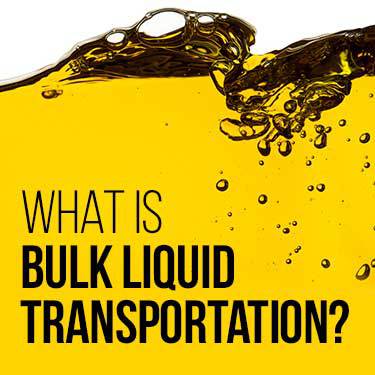
Bulk liquid transportation, to put it simply, describes the process of moving bulk liquids over long distances.
Since the bulk liquid isn’t packed into any other container before going into the back of a truck, it is extremely important to ensure that the trailer has no leaks—before putting the liquid inside. Even a tiny leak could result in a significant loss of fluid over time. By the time the truck gets to its destination, it could have lost most of the shipment!
Before the actual product is pumped into the back of a freight truck, the trailer is thoroughly examined for any dents, cracks, or other damages that could result in leaks. If there is an area of concern, the entire tank can be filled with water to test for leaks. Not only is a leaky tank inconvenient and expensive, but it is also illegal. Depending on what is being hauled, a spill could result in environmental or structural damage. Therefore, if you’re shipping something, it’s important for you to make sure your carrier has performed a tank inspection recently.
There are many different trailers that shippers can utilize to ship bulk liquids, ranging from standard ISO containers to plastic flexicontainers. However, the most widely used container for shipping both edible and inedible liquids is by far the bulk tanker.
Learn more about freight shipping in USA.
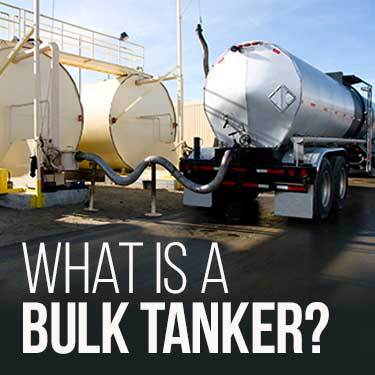
A bulk tanker is a large, cylindrical metal tank that is pulled behind a standard freight truck, like any other type of trailer.
There are several different kinds of tankers that can be used to transport bulk liquids. Some tankers are designed to keep the contents above a certain temperature, like with standard heated trucking. Others are designed to insulate the liquid or keep it cold, as a form of refrigerated shipping. Some tankers are purely cylindrical, for liquids to be pumped in and out using tubes, while others have hoppers on the bottom with valves, to make unloading easier. If a tanker has hoppers on the bottom, then it can be used to transport dry bulk goods as well, such as grains and dry beans. Other tank types include pressurized tanks and acid-resistant tanks.
Most bulk tankers have baffles on the inside to minimize the movement of the liquid inside the tank while the truck is on the road. These baffles act like different chambers, dividing up the liquid into smaller compartments. The reason this is helpful is that it prevents the entire weight of the liquid from surging up against the sides of the tank, which could result in instability and tipping.
A major difference between a bulk tanker and a standard dry van trailer is that tankers need to be cleaned much more often, and much more thoroughly. A tanker needs to be cleaned and sanitized after each load to ensure that the next load it carries isn’t contaminated by any residue left over from the previous shipment. This adds a lot of extra time and cost for the carrier, so shippers can expect bulk liquid transportation to be more expensive than dry bulk shipping.
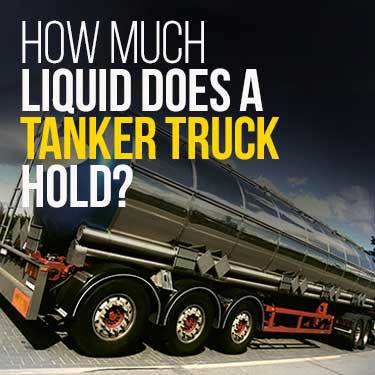
Bulk tankers can be quite large. The average tanker truck can hold between 6,000 and 7,000 gallons of liquid, but there are varieties that hold as little as 5,000 or as much as 11,600 gallons.
With that said, tanker trucks are not limited by the amount of liquid they could potentially contain. The U.S. Department of Transportation’s (DOT) Federal Highway Administration (FHA) mandates that the maximum weight limit for trucks on public roads cannot exceed 80,000 pounds. However, that depends on the number and kind of axles on the truck. A truck can sustain 20,000 pounds for each single axle it has, and 34,000 pounds for each tandem axle group.
This means that if the liquid you are trying to ship is particularly dense, like syrup or paint, then you might not be able to fill an entire large tanker truck. 11,600 gallons of syrup would weigh roughly 130,000 pounds, which far exceeds the weight limit for freight trucks. And that doesn’t even account for the weight of the truck itself! In order to ship such a dense liquid, you would need to utilize smaller tank trucks, or not fill the tank all the way to the top, in order to keep the truck under the maximum legal weight limit.
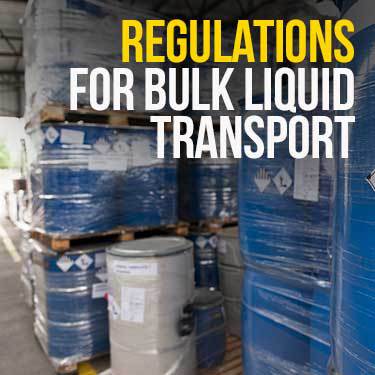
Bulk liquids can be heavily regulated depending on what they are. If you are transporting liquid intended for human consumption, such as juice, vegetable oil, or milk, then you will need to abide by the regulations established by the U.S. Food and Drug Administration (FDA). These regulations include sanitary handling of the food, proper worker hygiene, pest control, and employee training.
Say, for example, you are moving a shipment of milk. You would need to make sure that the milk isn’t exposed to the open air, especially outside. That means that the milk should be moved around and loaded into the trailer with the use of enclosed pipes or tubes. This prevents bugs and other debris from getting into the milk, while also avoiding potential contamination from workers. All holding containers, tubes, and tankers must be sterilized before the milk is allowed to come into contact with it. Otherwise, the FDA may deem the shipment unsafe for human consumption.
In addition to cleanliness requirements, you may be required to provide documentation of training, provide prior notice, and create a Hazard Analysis and Critical Control Point (HACCP) system.
However, foods aren’t the only bulk liquid products that are heavily regulated. Some liquids that are commonly shipped on a bulk tanker are classified as “Hazardous Materials,” such as pesticides, paint, and compressed gas. When you’re shipping HazMat freight of any kind, there are tons of regulations in place to protect you, your workers, the general public, infrastructure, and the environment.
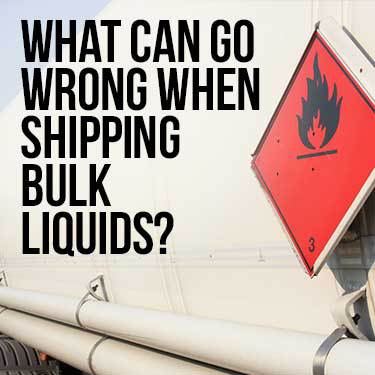
A lot can go wrong when shipping bulk liquids if the driver doesn’t know what they are doing.
Drivers must be extra careful when pulling a bulk tanker, especially if it isn’t completely full. The liquid inside the tanker sloshes around with the movement of the trailer, so if the driver brakes too hard or turns too fast, the weight of thousands of gallons of liquid could surge to one side and topple the trailer. This is why the use of baffles is so important. Not only does a toppled truck waste thousands of gallons of the shipper’s product, but it also poses a huge safety risk to other drivers on the road. If the shipment contained chemicals, then massive environmental damage could be sustained as well.
Even if the trailer stays upright, careless driving could result in the liquid getting agitated, creating foam. At best, foam can be annoying to deal with when unloading the trailer, but at worst, too much aeration could ruin the shipment.
Another thing that can go wrong with a bulk liquid shipment is contamination. Contamination can be a nightmare for shippers moving edible products like milk or syrup. If the tank isn’t properly cleaned before the next shipment is loaded into it, then residue from the previous shipment will contaminate it—even if the two loads were the same product. Imagine how terrible it would be to load fresh milk into a trailer that still has residue from the previous milk shipment inside it!
Finally, as discussed above, leaky tanks can pose a serious issue to bulk liquid shipments. If a leak goes unnoticed, then a significant amount of the product could be lost along the way.
All of this is to say that you should never cut corners when it comes to shipping bulk liquids. Don’t just go with the carrier that offers you the best price. You need to make sure that the carrier you are working with is qualified and experienced with shipping bulk liquids. The last thing you want is to lose thousands of gallons of your product just because you wanted to save a few bucks on shipping.
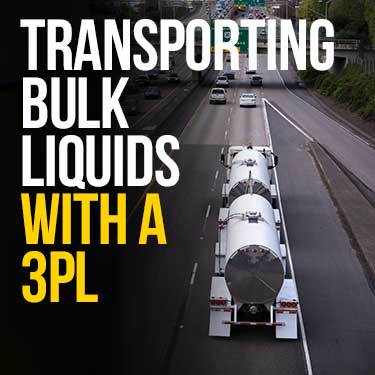
Ready for the good news?
Transporting bulk liquids doesn’t have to break the bank. You can save a great deal of money—without compromising on quality—by working with a Third-Party Logistics Company (3PL).
A 3PL is a company that works as a middleman in the logistics industry. They find the most reliable carriers on the road and create a huge network of experienced, thoroughly vetted drivers. When you work with a 3PL to move their shipment, those drivers bet on who gets to move your shipment. The carrier willing to charge the lowest rate is the one that ends up moving your goods, which gets you the best deal possible.
One of the major benefits of working with a 3PL, however, is the reliability. You don’t have to look for a carrier yourself, or try to gauge their trustworthiness and experience. When you work with a 3PL, all the responsibility of finding a good carrier is in their capable hands.
In addition to that, if you’re shipping regulated commodities, like food products or HazMat freight, then a 3PL can help you navigate the process with ease. The paperwork involved with shipping certain commodities can be overwhelming, and having someone available to help you through the process can save you time and needless stress.
Finally, many 3PLs offer in-house insurance, or discounts with partner insurance agencies. If your shipment is particularly valuable, as is the case with wine, maple syrup, and essential oils, then you shouldn’t even consider shipping them without getting some form of coverage to protect your investment.
Bulk liquid transport is simple when you work with a trustworthy 3PL like R+L Global Logistics! We’re the best in the industry in customer service, and our commitment to quality means your shipment will be in good hands with us! Our drivers have all passed rigorous inspections and are some of the most qualified carriers in the business.
We offer state-of-the-art shipping solutions for any kind of freight, including bulk liquids and hazardous materials. In addition to that, we can also boast advantages such as:
Plus, with our regular check-ins and complete transparency, you’ll never have to wonder where your bulk liquid shipment is! With R+L Global Logistics, you get more than just quality shipping solutions and friendly customer service. You get the peace of mind associated with knowing your shipment is being handled by the most reliable experts on the market.If you’re ready to get your shipment on the road, reach out to us today to get a free freight quote. You can fill out our online quote form, or give us a call at (866) 353-7178!
R+L Global Logistics
315 NE 14th St., Ocala, FL 34470